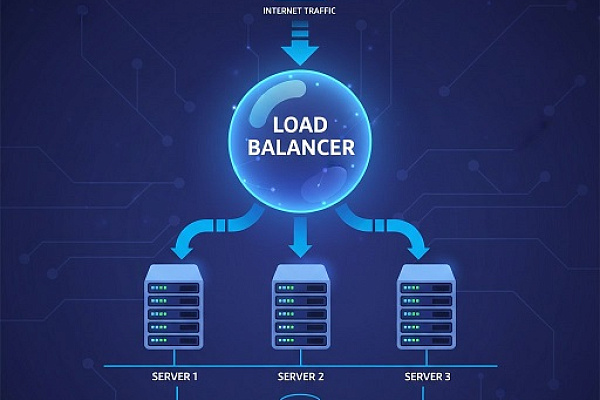Virtual Desktop Infrastructure (VDI) is a technology that hosts user desktops in a virtual environment on servers in a data center. With conventional VDI, virtual machines only use CPU and RAM, which is not enough for more demanding tasks.
GPU-accelerated VDI solves the performance problem by integrating GPUs into the virtual infrastructure. Unlike traditional VDI, where graphics are processed programmatically (e.g. through VMware Blast), physical GPUs are used here, either shared among virtual machines or allocated in their entirety.
How GPU-Accelerated VDI Works
A physical GPU (e.g. an NVIDIA Tesla V100 or P100) is connected to a server and managed by a hypervisor, such as VMware ESXi, Citrix Hypervisor or Microsoft Hyper-V. The cloud provider offers GPUs in three different ways.
-
Shared: a single GPU is split into multiple virtual GPUs (vGPUs), each of which is assigned to a different VM. For example, an NVIDIA A100 with 40 GB of memory can be split into four vGPUs, each with 10 GB of memory. This allows multiple users to run AutoCAD or Blender simultaneously without conflicts.
-
Dedicated (pGPU, also known as GPU passthrough): the entire physical GPU is tied to a single virtual machine. This approach is used where maximum performance is critical, for example in machine learning or professional video editing.
-
Emulated (API virtualization): graphics are processed not by the real GPU, but through software interfaces (e.g. Microsoft RemoteFX). This method is cheaper, but is only suitable for basic tasks such as office applications.
Special software is required for vGPU operation, so it is important to check with the cloud provider how work with its infrastructure is organized exactly.
Key use cases for GPU-accelerated VDI

Engineering & Design
-
CAD applications (Autodesk Inventor, SolidWorks) for automotive part design and virtual testing.
-
Architectural visualization in Revit and 3ds Max, enabling precise rendering and collaborative modeling.
Media & Entertainment
-
High-resolution video editing in DaVinci Resolve or Adobe Premiere Pro without expensive local workstations.
-
Distributed post-production workflows for film and TV studios.
Machine Learning & Data Analytics
-
Training neural networks and processing large datasets for financial forecasting.
-
Medical image analysis and biological process modeling.
Education & Research
-
Enables students to run 3D modeling and engineering software remotely, eliminating costly lab hardware.
Government & Defense
-
Securely processes sensitive data in centralized data centers, preventing leaks while supporting complex geospatial and technical design tasks.
Advantages of GPU-accelerated VDI
1. Flexible Resource Scaling
-
Rapidly deploy additional workstations for new projects (e.g., scaling Autodesk Revit for a growing team).
-
Shut down unused resources to optimize costs.
2. Customizable Performance
-
Adjust CPU, RAM (16GB to 256GB+), and GPU configurations per workload.
-
High-speed SSD storage minimizes latency for large files.
3. Enhanced Security
-
Data remains in a secure Tier III data center, compliant with 152-FZ/GDPR.
-
Thin clients reduce endpoint risks—only desktop images are transmitted.
4. High-Performance Computing
-
3x faster CAD rendering vs. software solutions.
-
Supports CUDA, RT Cores, and 8K video processing via NVENC/NVDEC.
-
Enables parallel 3D scene rendering with NVIDIA vComputeServer.
5. Cost Optimization
-
40% lower TCO over 3 years vs. traditional workstations.
-
Eliminates frequent hardware upgrades and reduces power consumption.
-
Pay-as-you-go pricing and instant disaster recovery minimize downtime.
Issues resolved by GPU-powered VDI
VDI with GPU solves a range of complex issues associated with organizing high-performance workstations for specialists working with resource-intensive applications.
The main advantage is that expensive workstations with professional graphics cards are no longer required for each employee. Instead, powerful GPUs are distributed among multiple users via virtualization. This achieves capital cost savings of 3–5 times those of the traditional approach, while delivering comparable performance for most professional tasks.
A critical aspect is the centralized storage of data in a secure data center rather than on local workstations. This reduces the risk of confidential information leakages. Modern security mechanisms are implemented, including end-to-end encryption. This approach is particularly important for organizations working with personal data, as it ensures compliance with regulatory requirements such as 152-FZ or GDPR.
Another key benefit is the flexible scalability of computing resources. GPU-accelerated VDI enables the infrastructure to adapt dynamically to changing workloads, whether that involves temporarily increasing a user's video memory or automatically adding GPUs as the workload grows. This is particularly valuable for project work where needs can fluctuate.
Additional benefits include support for specialized workloads and high-performance computing, significant reductions in power consumption through resource consolidation, and the ability to create hybrid infrastructures that combine on-premises and cloud-based GPU resources. These changes are transforming the economics of IT infrastructure, shifting the focus from capital expenditure to operational expenditure and providing more predictable budgets and controlled risks.
Cloud4Y’s GPU-powered VDI solutions
Today's business challenges require an IT infrastructure that is flexible, secure and cost-effective. VDI with GPU is more than just desktop virtualization; it is a technology that:
-
Reduces costs by eliminating the need to buy expensive desktops and upgrade them annually.
-
Increases security, as data stays in a secure data center rather than on local devices.
-
Provides flexibility, as resources can be scaled in minutes to meet project needs.
-
Provides access to professional GPUs — even from a standard laptop, employees can work in AutoCAD, Blender or DaVinci Resolve without any loss of speed.
Cloud4Y offers GPU-ready VDI solutions suitable
for engineering, design, scientific and media applications. Our infrastructure
is built on certified hardware and provides high availability (99.982% SLA), as
well as being 152-FZ compliant.



